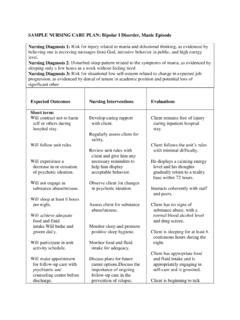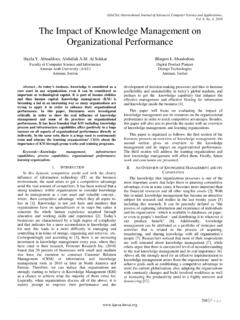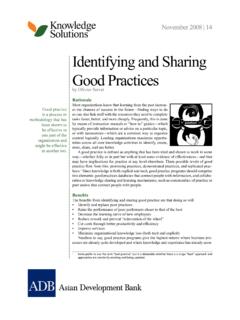Transcription of CHAPTER 15 MADELEINE L CARE: D U T - nursing.jbpub.com
1 CHAPTER 15. MADELEINE LEININGER'S. culture CARE: DIVERSITY. AND UNIVERSALITY THEORY. MADELEINE Leininger was born in Sutton, Nebraska. In 1948, she received her diploma in nursing from St. Anthony's School of Nursing in Denver, Colorado. In 1950, she earned a from St. Scholastica (Benedictine College) in Atchi- son, Kansas, and in 1954 earned an in psychiatric and mental health nurs- ing from the Catholic University of America in Washington, In 1965, she was awarded a in cultural and social anthropology from the University of Washington, Seattle (Tomey and Alligood, 2001).
2 Early in her career as a nurse, Leininger recognized the importance of the concept of caring in nursing. Frequent statements of appreciation from pa- tients for care received prompted Leininger to focus on care as being a cen- tral component of nursing. During the 1950s, while working in a child guidance home, Leininger experienced what she describes as a cultural shock when she realized that recurrent behavioral patterns in children appeared to have a cultural basis. Leininger identified a lack of cultural and care knowledge as the missing link to nursing's understanding of the many variations required in patient care to support compliance, healing, and wellness (George, 2002).
3 These insights were the beginnings (in the 1950s) of a new construct and phe- nomenon related to nursing care called transcultural nursing. 93. 94 Understanding the Work of Nurse Theorists Leininger is the founder of the transcultural nursing movement in educa- tion research and practice. In 1995, Leininger defined transcultural nursing as: a substantive area of study and practice focused on comparative cultural care (caring) values, beliefs, and practices of individuals or groups of similar or different cultures with the goal of providing culture -specific and universal nursing care practices in promoting health or well-being or to help people to face unfavorable human conditions, illness, or death in culturally meaningful ways (p.)
4 58). The practice of transcultural nursing addresses the cultural dynamics that influence the nurse client relationship. Because of its focus on this specific aspect of nursing, a theory was needed to study and explain outcomes of this type of care. Leininger creatively developed the Theory of culture Care: Diversity and Universality with the goal to provide culturally congruent wholistic care. Some scholars might place this theory in the middle range classification. Leininger holds that it is not a grand theory because it has particular dimen- sions to assess for a total picture.
5 It is a wholistic and comprehensive approach, which has led to broader nursing practice applications than is tra- ditionally expected with a middle-range, reductionist approach. (Personal communication with Penny Glynn on September 12, 2003). Leininger's theory is to provide care measures that are in harmony with an individual or group's cultural beliefs, practices, and values. In the 1960's she coined the term culturally congruent care, which is the primary goal of transcul- tural nursing practice. Culturally congruent care is possible when the follow- ing occurs within the nurse-client relationship (Leininger, 1981): Together the nurse and the client creatively design a new or different care lifestyle for the health or well-being of the client.
6 This mode re- quires the use of both generic and professional knowledge and ways to fit such diverse ideas into nursing care actions and goals. Care knowl- edge and skill are often repatterned for the best interest of the clients Thus all care modalities require coparticipation of the nurse and clients (consumers) working together to identify, plan, implement, and evaluate each caring mode for culturally congruent nursing care. These modes can stim- ulate nurses to design nursing actions and decisions using new knowl- MADELEINE Leininger 95. edge and culturally based ways to provide meaningful and satisfying wholistic care to individuals, groups or institutions (Leininger, 1991, p.)
7 44). Leininger developed new terms for the basic tenets of her theory. These definitions and the tenets are important to understand. Understanding such key terms is crucial to understanding the theory. Below is a basic summary of the tenets that are essential to understand with Leininger's theory (summa- rized from Leininger, 2001, pp. 46 47): Care is to assist others with real or anticipated needs in an effort to improve a human condition of concern or to face death. Caring is an action or activity directed towards providing care. culture refers to learned, shared, and transmitted values, beliefs, norms, and lifeways of a specific individual or group that guide their thinking, decisions, actions, and patterned ways of living.
8 Cultural care refers to multiple aspects of culture that influence and en- able a person or group to improve their human condition or to deal with illness or death. Cultural care diversity refers to the differences in meanings, values, or ac- ceptable modes of care within or between different groups of people. Cultural care universality refers to common care or similar meanings that are evident among many cultures. Nursing is a learned profession with a disciplined focused on care phenomena. Worldview refers to the way people tend to look at the world or universe in creating a personal view of what life is about.
9 Cultural and social structure dimensions include factors related to religion, social structure, political/legal concerns, economics, educational pat- terns, the use of technologies, cultural values, and ethnohistory that in- fluence cultural responses of human beings within a cultural context. Health refers to a state of well-being that is culturally defined and valued by a designated culture . Cultural care preservation or maintenance refers to nursing care activities that help people of particular cultures to retain and use core cultural care values related to healthcare concerns or conditions.
10 Cultural care accommodation or negotiation refers to creative nursing actions that help people of a particular culture adapt to or negotiate with oth- ers in the healthcare community in an effort to attain the shared goal of an optimal health outcome for client(s) of a designated culture . 96 Understanding the Work of Nurse Theorists Cultural care repatterning or restructuring refers to therapeutic actions taken by culturally competent nurse(s) or family. These actions enable or as- sist a client to modify personal health behaviors towards beneficial outcomes while respecting the client's cultural values.










